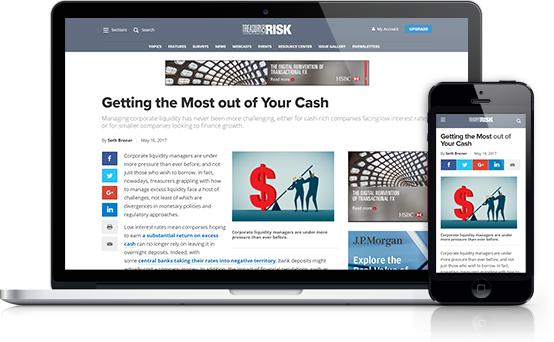 Credit: derrrek/Getty Images.
Credit: derrrek/Getty Images.
As 2025 unfolds, financial institutions are accelerating their integration of digital assets into payment systems, driven by greater regulatory clarity, the approval of spot ETFs (exchange-traded funds), and a growing decentralized finance ecosystem. In 2024 alone, the total cryptocurrency trading volume hit $18.4 trillion, the second highest on record, signaling renewed momentum.
Despite the optimism, however, concerns remain about cryptocurrencies, especially among treasurers tasked with keeping corporate assets safe. Cryptocurrencies are often volatile and are prone to market fluctuations since they’re lacking in underlying assets. Within this landscape, “stablecoins”—whose value is pegged to fiat currencies like the U.S. dollar or euro—have emerged as a game-changer.
The market for stablecoins topped $200 million in 2024, and large financial institutions and financial technology companies have taken notice. Paypal, Ripple, and Stripe have all launched their own stablecoins, and Bank of America recently signaled it would be open to following suit. Stablecoins tied to local currencies have also proliferated. StraitsX’s XSGD, pegged to the Singapore dollar, has gained significant traction in Asia, and Standard Chartered recently announced plans to lead a venture to launch a Hong Kong dollar–backed stablecoin.
The momentum behind stablecoins means treasury should no longer ignore them. Instead, corporate treasurers should be preparing for stablecoins to become more prevalent in the coming months. What are the benefits for treasury teams?
Why Stablecoins Should Be on Treasurers’ Radar
Like other digital currencies, stablecoins can facilitate near-instantaneous cross-border payments with significantly lower fees. When companies make cross-border payments through traditional banks, those payments can take up to five days to clear and can involve multiple intermediaries. Processing of stablecoins is more direct and efficient, leading to much faster payment clearing.
Stablecoins are digital tokens that are stored on a blockchain, which means that—unlike traditional cross-border payments, which are dependent on Swift, or payments routed through multiple banks—stablecoin payments can be facilitated without an intermediary. They can also clear instantly, regardless of geographical location. Crucially, and unlike traditional payments, stablecoins do not require payment to a network gatekeeper. These characteristics have significant value, especially for small businesses that may struggle with the high costs associated with international payments. Helpfully, digital wallet technologies now allow for the storage of stablecoins, alongside other assets like central bank digital currencies (CBDCs), making it simpler to use stablecoins to pay for goods and services.
Although other digital currencies can also improve the speed and pricing of international payments, stablecoins have a key advantage over other digital or crypto assets. The fact that their value is pegged to a fiat currency increases their security, transparency, and reliability in financial transactions, which makes them a viable payment option for goods and services in the real economy.
As the cherry on top, stablecoins also comply with current laws and can neatly fit into traditional banking practices.
Regulation Coming down the Tracks
The increasing interest in, and adoption of, stablecoins is prompting regulators to step in with new compliance frameworks. This helps increase the legitimacy of the digital currencies, but the evolving nature of the regulatory landscape creates uncertainties that treasurers must navigate.
In the United States, policymakers are currently working to clarify guidelines for stablecoins. A stablecoin bill that is now under discussion could provide the framework needed for broader institutional adoption. Similarly, the European Union’s (EU’s) Markets in Crypto-Assets (MiCA) regulation sets legal parameters for stablecoin payments, requiring issuers to partner with licensed financial institutions. The UK is also developing a regulatory framework for stablecoin issuance and staking. These regulations are designed to build trust in stablecoins and provide a more structured environment for companies to use stablecoins for their payment processes.
While these regulatory developments are positive, they do introduce compliance challenges. Treasurers can stay ahead of the stablecoin curve by assessing how the rules may impact their banking partners and virtual asset service providers (VASPs) to ensure seamless integration with existing systems. For treasurers who do not consider themselves savvy about digital currencies, the best practice is to read about the regulations and have conversations with banking partners, who likely have specialized teams dedicated to navigating the changing regulatory landscape.
Be Aware of the Risks
Treasurers who decide to integrate stablecoins into their payment strategies need to acknowledge that they are not entirely risk-free. As with any asset, stablecoins would pose liquidity risks in the case of a bank run. There is also the risk of de-pegging, wherein the value of a stablecoin deviates from the fiat currency to which it is pegged. This can occur in the event of rapid market fluctuation, liquidity stresses, or impairment of the reserves backing the stablecoin.
Treasurers should also consider the broader nature of the stablecoin landscape and the security setups for the asset each stablecoin is tied to. Because the value of stablecoins depends on the fiat currencies to which they are pegged, treasurers should closely monitor the safeguarding arrangements for the fiat units and ensure the stablecoin issuers have sufficient reserves.
One key concern surrounding stablecoins is their potential use as vehicles in financial crime, due to the anonymous and fast nature of transactions. Treasurers should therefore also ensure that their stablecoin issuers have implemented robust know-your-customer (KYC), anti-money laundering (AML), and customer due diligence processes.
Next Steps for Treasurers
The jury is out as to whether stablecoins will eventually replace traditional payment methods, but adoption is on the increase. To avoid being left behind, treasurers should stay informed of the regulatory landscape, educate themselves on the risks of stablecoin use, and evaluate the best partners and platforms for stablecoin transactions.
As the financial environment continues to evolve, treasurers who stay abreast of the changes and embrace innovation will be better prepared to succeed in the future.
© 2025 ALM Global, LLC, All Rights Reserved. Request academic re-use from www.copyright.com. All other uses, submit a request to [email protected]. For more information visit Asset & Logo Licensing.





